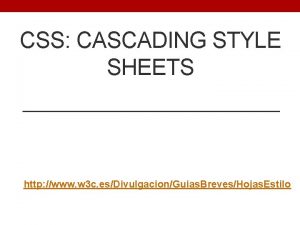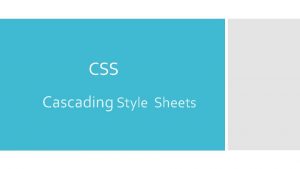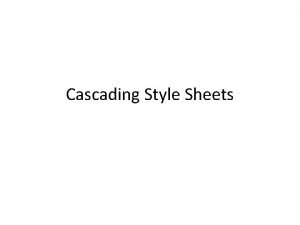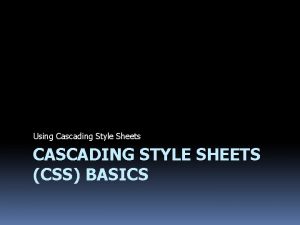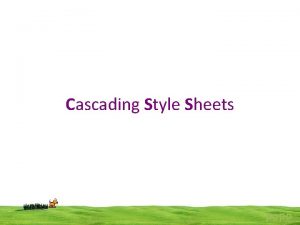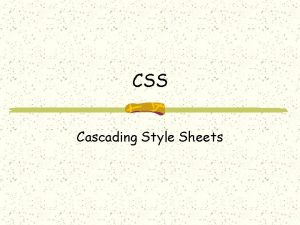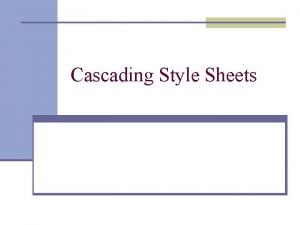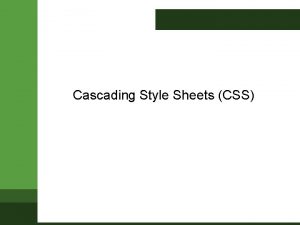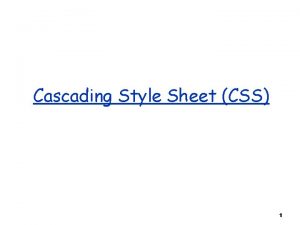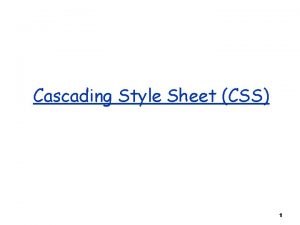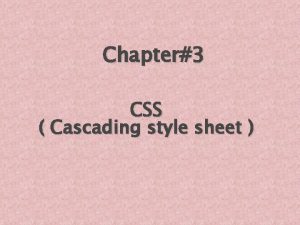Cascading Style Sheets CSS Introduction To CSS n











- Slides: 11

Cascading Style Sheets CSS

Introduction To CSS n n CSS works by allowing your associate rules with the elements that appear in document. Each style rule in a style sheet has two main parts • The selector, which indicates which element or elements the declaration applies to. • The declaration, which sets out how the elements should be styled.

Introduction To CSS n The declaration is also split into two parts, separated by a colon: • A property, which is the property of the selected element(s) that you want to affect. • A value, which is a specification for this property; in this case it is the Arial typeface.

Adding Style to a Document n Linking to a Style Sheet (External CSS) • Can set style for many documents with one style sheet. • Style information cached by the browser. • The common style sheet document extension is. css, for Cascading Style Sheets. Syntax n <link rel=“stylesheet “ href=“main. css” type=“text/css”> • rel attribute is used to indicate the relationship for the link element. • href attribute is used to indicate the URL of the style sheet to use. • type attribute is used to indicate the linked style sheet is a cascading style sheet (CSS).

Adding Style to a Document n Embedding and Importing Style Sheets • Can easily control style document by document. • No additional page requests for style information. • Syntax <style> /*style rules here*/ h 1{backgroudcolor: red; } </style>

Adding Style to a Document n Using Inline Style • Can easily control style to a single character instance. • Overrides any external or document styles. • Syntax <h 1 style=“font-size: 48 pt; font-family: Arial; color: green; ”>CSS 1 Inline</h 1> • style attribute is used to add style information directly in a tag.

Understanding Block and Inline Elements n Block-level elements appear on the screen as line break before and after them. • For example the <p>, <h 1>, <h 2>, <h 3>, <h 4>, <ul>, <ol>, <hr>, and <hr>elements are all block level elements. n Inline elements, on the other hand, can appear within sentences and do not have to appear on a new line of their own • For example the <b>, <i>, <u>, <sub>, and <li> elements are all inline elements.

Grouping Elements with <div> and <span> n n The <div> and <span> elements allow you to group together several elements to create sections or subsections of a page. They are commonly used with CSS to allow you to attach a style to a section of a page. <div> is the block-level element <span> is the inline-level element

Selectors n Universal Selector • The universal selector is an asterisk; it matches all element types in the document. *{background-color: ”red”; } n The Type Selector • The type selector matches all of the elements specified in the comma-delimited list. It allows you to apply the same rules to several elements. h 1, p, b{font-family: ”arial”; }

Selectors n The Class Selector • The class selector allows you to match a rule with an element carrying a class attribute whose value you specify in the class selector. <p class="Background. Note">This paragraph contains an aside. </p>. Background. Note {font-size: ” 24 px”; } • Creating a selector that selects only the <p> elements that carry a class attribute with a value of Background. Note p. Background. Note {font-size: ” 24 px”; }

Selectors n ID selector • The id selector works just like a class selector, but works on the value of id attributes. <p id=“abstact”>Hello world</p> p. #abstract {font-size: ” 24 px”; }
 Cascading style sheets outlook
Cascading style sheets outlook Cascading style sheets definition
Cascading style sheets definition Syntactically awesome stylesheets
Syntactically awesome stylesheets By default a background image will repeat
By default a background image will repeat Css button style generator
Css button style generator Contoh logic model
Contoh logic model Fractional cascading
Fractional cascading Dynamic logic circuits
Dynamic logic circuits Actuator circuit diagram
Actuator circuit diagram Customer intimacy strategy map
Customer intimacy strategy map Cascading consequences
Cascading consequences Cascading behavior in networks
Cascading behavior in networks

